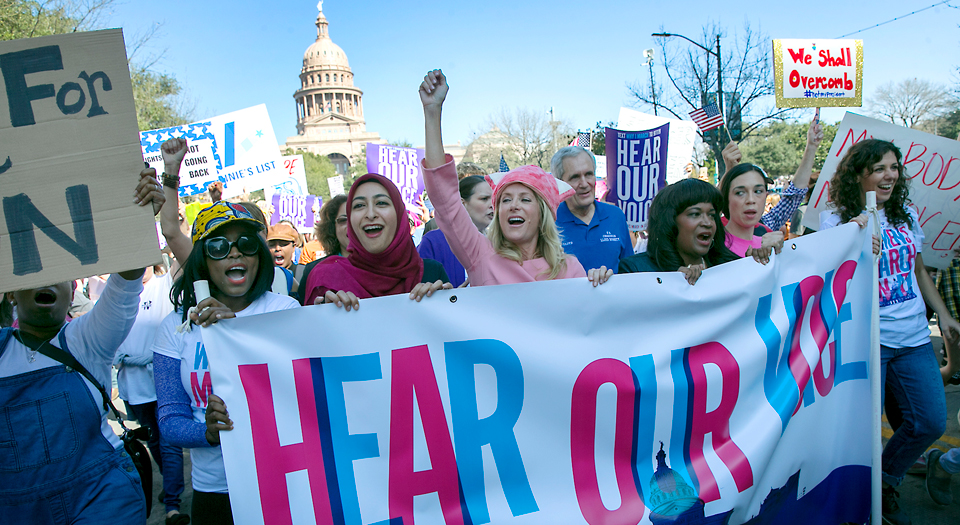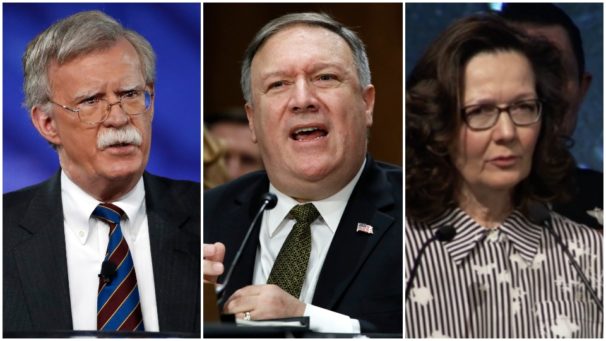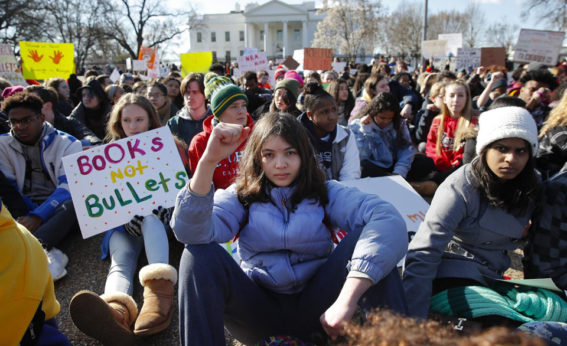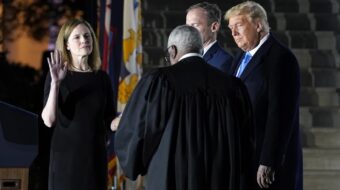
The bombing of Syria.
The FBI raid on the offices of Trump’s lawyer, Michael Cohen.
The retirement of House Speaker Paul Ryan from Congress.
The tell-all book by former FBI director James Comey.
Trump’s renewed threats to fire Special Counsel Robert Mueller.
The Cambridge Analytica and Facebook data scandal.
These are all politically earth-shattering events, and in any other period a single one of them might be enough to rock a presidential administration to the point of crisis. Coming together within days of one another, however, they are nothing less than head-spinning.
Such headlines, however, as absolutely important as they are, carry the risk of diverting attention from some other alarming developments that carry ominous implications for democracy and peace. An appreciation of the new mass democratic movements that are now rising to meet these challenges is just as essential to understanding and acting in the current moment.
The ‘war cabinet’ assumes control
The presence of new National Security Advisor John Bolton, as well as the expected approval of Secretary of State nominee Mike Pompeo and CIA director nominee Gina Haspel, represent a further turn to the right by the Trump administration. They mark the assembling of a “war cabinet,” according to many.

They are now part of the concoction that includes the burgeoning corruption scandals and conflicts of interest which are affecting every foreign policy decision of the Trump administration.
The elevation of the war cabinet coincides with the purge of two officials who Trump had put in place as a compromise with the GOP foreign policy establishment—Rex Tillerson and H.R. McMaster. Both challenged Trump on occasion and were in favor of maintaining the Iran nuclear deal. Tillerson also opposed military action against North Korea.
Some see Secretary of Defense James “Mad Dog” Mattis as a restraining force on Trump’s militaristic impulses, but during the Obama administration, Mattis was widely dismissed as a warmonger. It should be remembered that it was Mattis who chillingly described the mass destruction the U.S. military could rain on North Korea if it so chose.
Trump has increasingly clashed with White House chief of staff John Kelly, a white supremacist who likes to repaint the history of the Civil War in distinctly pro-Confederate colors. Trump’s public criticisms undermine Kelly, however, and point to his eventual ouster too.
In bringing in Bolton, Pompeo, and Haspel (who was instrumental in designing and carrying out the illegal CIA torture operation during the Iraq War), in addition to Stephen Miller, Trump is consolidating his power and surrounding himself with loyalists, dangerous warmongers, and Islamophobes.
This development consolidates the trio of a supposed “America First” foreign policy, an economic nationalist-driven trade policy, and a white supremacist and “ethno-nationalist”-determined immigration and social policy.
Bolton and Pompeo believe in military might, confrontation, and unilateralism in foreign policy. They disdain international institutions, diplomacy, global cooperation, and treaties—including on nuclear non-proliferation and climate change.
The ascendancy of these forces in the Trump administration increases the likelihood of a war provocation in the Middle East, a pre-emptive attack on North Korea, as well as the acceleration of a new nuclear arms race and possibly even the actual use of nuclear weapons.
The ascendance of the war cabinet thus constitutes a new phase of the Trump administration. The prospect is for a more chaotic, repressive, authoritarian administration imbued with white supremacy and ethno-nationalism that more aggressively challenges democratic norms and rights domestically while threatening military intervention abroad.
It dangerously increases the possibility Trump will spark a constitutional crisis by seeking to end the Mueller investigation.
Trump himself is driving this process. It reflects his intent to rule by fiat, with those around him loyally supporting his impulses and goading him on.
History teaches us fascist regimes don’t come into being overnight. They go through various stages of development, marked by chaos and consolidation—steps toward authoritarianism. They become more radicalized at each critical point.
Especially amid the chaos of a potential constitutional crisis and extreme nationalism induced by war, a full-blown fascist regime can emerge—a possibility even more imaginable given how tightly the Trump administration is already tied to the so-called “alt-right”, or rebranded fascists and their oligarchic backers.
This ascendance of the war cabinet consolidates the trio of an “America First” foreign policy, an economic nationalist-driven trade policy, and a white supremacist and “ethno-nationalist”- determined immigration and social policy.
Another dangerous factor is the grouping of Breitbart News, Fox News, and Sinclair Broadcasting into a massive propaganda arm of the Trump White House. This powerful right-wing communications apparatus holds a sizeable section of the country politically and ideologically captive.
So far, the Republican Party is offering no restraint to the direction pursued by Trump. In fact, the GOP refuses to pass legislation that would block the removal of Mueller. The party leadership is aiding and abetting Trump’s every move because they fear primary challenges far more than they do a general election debacle for Republican candidates. Despite mounting special election losses, they are still not breaking from Trump, except for those who are deciding not to run again.
Trump and the GOP are thus left to radicalize together. Trump is constantly upping the ante to appeal to the 35-40 percent of the population that make up his base of supporters with heavy doses of fear, racism, misogyny, xenophobia, militarism, and nationalism.
These developments underscore the absolute urgency of defeating the GOP in the 2018 elections and mobilizing and uniting every force possible to achieve this.
Bolton is evil
Trump wanted to bring Bolton into the administration earlier, but his nomination to be Deputy Secretary of State was blocked by Tillerson, and his access to the White House was restricted by Kelly. Much of the GOP foreign policy establishment sees Bolton as a dangerous kook.
Bolton, who left his job as a Fox News commentator to enter the administration, is tied to the Mercer family, owners of Breitbart News and Cambridge Analytica. He is a long-time neocon proponent of invasion and regime change in Iraq, Syria, and Iran. In fact, he is often even to the right of what passes for mainstream neocon policy.
To this day, Bolton refuses to admit the Iraq War was a catastrophic mistake. It’s no coincidence that Trump began planning for a military strike against Syria on Bolton’s first day on the job.
Bolton played a key role during the Bush Administration as an ally of Vice President Dick Cheney and, behind the scenes, attempted to set up Iran for invasion. His modus operandus is lies, false propaganda, and provocation.
Bolton was also a supporter of moving the U.S. embassy in Israel to Jerusalem, expanding illegal settlements in Palestinian territory, and scrapping the nuclear agreement with Iran.
Neocon ideologues are also pushing a new confrontational cold war with Russia and China. They are exploiting the Russian intervention in the 2016 U.S. elections to ratchet up hostilities. Any military action with Iran, Syria, and North Korea is ultimately a confrontation with Russia and China.
According to Bolton, Russia and China “fly wingman for each other” at the United Nations and have a “de facto territorial division of labor around the world.” Though Bolton’s claim of a grand Russia-China alliance is a stretch beyond reality, it is the case that, for different reasons, each of these two countries are a challenge to U.S. geopolitical strategic interests.
Recent developments on the Korean peninsula are making it harder to militarily attack North Korea, however much Bolton and those like him might desire to. These developments include the summit between the two Koreas, the visit by North Korean leader Kim Jong Un to China, and Kim’s upcoming meeting with Trump. Any military attack on North Korea would lead to destruction and loss of life on an unimaginable scale and draw China into a direct confrontation with the U.S.
Iran, on the other hand, is weak both militarily and economically and somewhat isolated internationally, making it much more vulnerable. Other proponents of regime change in Iran include the extreme right-wing government of Israel, the reactionary theocratic states of Saudi Arabia and United Arab Emirates, and right-wing evangelicals in the U.S.
A major war in the Middle East, should one happen, would stoke Islamophobia and anti-Semitism. It would increase authoritarianism and the danger of fascism in the U.S. under the pretext of threats to “national security.” It would increase repression against Muslims and immigrants.
A war could also fuel a wider nuclear arms race in the Middle East led by Iran, Saudi Arabia, and Israel, and globally with Russia and China.
Resistance also enters a new stage
The “small-d” democratic movements are reaching new levels of organization and collaboration, responding to every new outrage of the Trump administration in the streets and winning victories by electing Democratic candidates in special elections. Democratic voters across the country are energized, a factor which bodes well for the 2018 elections.
The most exciting developments are the new mass movements emerging forcefully on the scene. They are objectively anti-extreme right, and extend the breadth and depth of this movement by involving millions.
First, is the ongoing #MeToo movement. Women of all races and ages are playing leading roles and energizing every struggle that they become involved in, including the electoral arena, where thousands are running for office. This movement is transforming politics, culture, and electoral action.
The other exploding mass movements around gun violence and striking teachers reflect tipping points in response to the impact of right-wing policies.
The horrific mass shooting at Marjory Stoneman Douglas High School in Parkland, Florida sparked the emergence of a national student movement against gun violence. The growing revulsion against mass shootings, daily gun violence, the National Rifle Association, and inaction by GOP elected officials has reached a tipping point.
What is so unprecedented is the emergence of a movement on this scale initiated and largely led by high school students.
The approach toward mass and electoral activism among the students leading the movement against gun violence is very sophisticated. They transition seamlessly from street protest and lobbying to voting and running for office. They see participation in all forms of struggle with an emphasis on democratic, militant non-violent peaceful resistance.
Some of the largest demonstrations to date were organized in a matter of weeks. These actions reflect deep-seated opposition to the NRA and gun industry, a key support base of the extreme right and GOP. The full weight of the right wing has been marshalled against the students, but they are courageously standing their ground.
The victims of mass shootings, in this case at a majority white, wealthier high school, have intersected with already existing majority African-American, Latino, and Native American movements against daily gun violence, racist police brutality, and institutional violence—including school closures, poverty, and defunding in communities of color.
Something new and more powerful has emerged from this intersection: a political and moral movement led largely by young people, the actual victims of gun violence. This movement has skillfully utilized the organizing and communication power of social media. The movement’s multiracial character and the advancing attitudes of white youth toward racism and white privilege bring a new level of development.
Their approach toward mass and electoral activism is also very sophisticated. They transition seamlessly from street protest and lobbying to voting and running for office. They see participation in all forms of struggle with an emphasis on democratic, militant non-violent peaceful resistance.
This movement is inspiring millions and tapping into the majority sentiments of the American people. It is unifying students, parents, teachers and school staff, principals, superintendents, school boards, and cultural and sports figures, while also giving Democratic candidates backbone to confront the NRA.
Red state teacher rebellion
Teacher strikes in West Virginia and Oklahoma and the walkouts in Arizona, Kentucky, and elsewhere are another sudden and unexpected explosion of democratic struggle. Who could have predicted this development other than the teachers themselves, who are fed up?
It is no accident this rebellion is occurring first in states dominated by right-wing GOP governments. Right-wing fiscal policy is ravaging state budgets, education, and social services.
The demands go way beyond teacher wages, health care, and pensions to include reversing massive cuts made to school funding (often the result of major corporate tax cuts).

In Oklahoma, the GOP cut education funding per student 30 percent over the past 10 years. Teachers there are paid poverty wages, classrooms have been stripped of resources, buildings are dilapidated, and textbooks are ancient and tattered. Twenty percent of schools in Oklahoma are operating four days a week.
Rebelling teachers in the red states are courageously fighting under conditions of right-to-work, strike illegality, and, in the case of the West Virginia, rank and file teachers taking on a cautious union leadership.
The fight by teachers has created the basis for the broadest possible unity and solidarity. Teachers are supported by majority public opinion, parents, students, other school support personnel, principals, superintendents, and local school boards. Even people who are not yet ready to break with Trump and the GOP nationally are on board with the agenda being put forward by the teachers.
Achilles heel of the GOP
Many teachers, parents, and administration personnel no doubt voted for Trump and GOP candidates in 2016. While many may have supported Trump on social issues like immigration and abortion, they don’t support fiscal policies of tax cuts for the rich and savage cuts to education and healthcare.
These mass movements create the possibility of a class and social break with Trump and the right wing. They open the possibility of flipping GOP congressional and state legislative seats. The challenge remains of how to influence voters— particularly whites swayed by racism, anti-abortion, and anti-immigrant sentiments—toward positions of multiracial class and people unity. People are a complex mix of contradictory ideologies—a mix that changes as developments unfold. Change happens, but not overnight.
With these extraordinary developments—the escalation of danger from the Trump administration and the explosion of new mass democratic movements—unity and a laser focus on the 2018 elections are imperative.
Class and social forces are moving and changing at different rates in response to developments and experiences. New movements are arising. There will be disagreements on one issue or another, and some Democratic Party candidates will undoubtedly not be as advanced as others, depending on the state and congressional district and the balance of class and social forces. Broad and flexible tactics continue to be essential to ensure victory in 2018 and 2020 and to shift the political landscape to make way for far more radical social change ahead.
This article is based on remarks delivered by the author at the meeting of the National Board of the Communist Party on April 9, 2018.












Comments